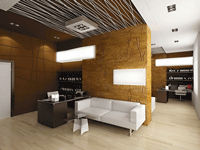#Time tracking
Time tracking terminals. |
Purpose
The efficiency of any enterprise largely depends on the efficiency of its employees.
The issue of labor discipline plays an important role in this — management, of course, wants to pay its employees for the time actually worked time.
It is important to take into account that it is often difficult to control such violations of labor discipline as tardiness, unauthorized absences, and premature departure from the workplace directly through administrative measures.
In order to improve the efficiency of discipline monitoring, automate timekeeping and payroll, and to solve a number of other similar problems, almost any access control and management system (ACS) is equipped with a software function for recording working hours (WAT), which is perhaps the most popular additional function implemented by the ACS.
But in some cases, there is a need to record working hours without reference to the access control point — for example, when the employee's workplace is located at a considerable distance from the general checkpoint.
To solve such problems, terminals for recording working hours are used.
URV terminals are a device or system that implements employee passage identification without organizing a passage point.
The use of URV terminals allows managers, HR and accounting staff to solve the problems of monitoring employee labor discipline in accordance with Labor Law, create an evidence base in labor disputes and prevent the possibility of errors and abuses.
The URV terminals include indication and control devices that allow the employee to directly see the entry/exit time and, in some devices, to set the reason for the passage (entry, exit, temporary exit, lunch break, business trip, etc.), which is automatically taken into account by the terminal when recording the working time of this employee.
Special software, using data on the arrivals/departures of employees, allows for the automation of working time recording.
Filling out the timesheet is done using standard forms, and multi-shift and flexible work schedules are usually supported. Each employee's work schedule is entered into the computer — either individual, or by department, or general for the enterprise.
In the future, the system's operation algorithm will depend on the specific organization scheme of the control system.
Identification in URV terminals is carried out in three main ways: biometric readers (at least 60% of devices used today), contactless card readers (up to 30%) and barcode readers (up to 10%, and the share of these devices is steadily decreasing).
Below are the characteristics of the timekeeping terminals presented on the Russian market that work on contactless cards.
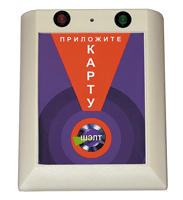
ADEMANT-500-F Mobile Controller (Shelni, Russia)
It is one of the elements of the Shelt® access control system and is used to organize working time accounting.
The controller can operate in a mode of constant connection to a computer or — with registration of working time independently from the computer, with recording in the database from the controller's memory episodically when the controller is connected to the computer.
The controller includes a contactless card reader of the EM-Marine type (Weigand-26 output format).
The card code received by the reader is compared with the codes of the cards loaded into the controller's memory, and for a valid card, the green LED lights up.
The controller is made in a desktop case and has a type B connector for connecting a standard USB cable of type AB for connection to the USB port of a computer.
When working with software (for registering cards, entering a list of cards into the controller, receiving an event log), the controller connected to a personal computer does not require an external power source; power is supplied via the USB interface. When operating autonomously, the controller is powered from an external power source.
The controller is designed for continuous round-the-clock operation in closed rooms not exposed to precipitation, at temperatures from –20°C to +50°C.
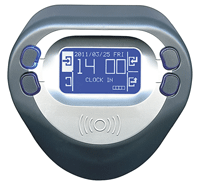
TR610 Time and Attendance Monitoring Terminal (GigaTMS, Taiwan)
Designed for building time and attendance monitoring systems using proximity cards.
With its clear display and 4 keys, the TR610 has an intuitive interface. The use of associative icons will allow new users to quickly figure out how to register an event on the terminal.
The display also shows the time, date and memory status.
Ethernet connection and a built-in web server make the TR610 easy to administer remotely.
The web interface allows you to set any device settings, as well as view or download a list of events from the terminal.
Of interest to system integrators and developers is that the terminal can be programmed in Tibbo BASIC, and its internal program is supplied free of charge with open source and can be edited to suit your requirements.
The terminal is equipped with an RS232 interface for connecting external devices. Thanks to the built-in relays, it is possible to connect an electric lock and an alarm device. The built-in 1MB flash memory can store up to 175,000 events.
Identification can be carried out using contactless RFID cards of the E-Marine 125 kHz (TR610R) or Mifare 13.56 MHz (TR610MF) standard.
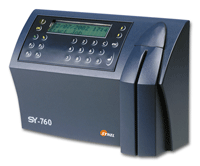
Terminal for recording working hours SY760/780 (Synel Israel)
The SY7XX terminal as part of the TimeLOG complex is a boxed solution for automated accounting of working hours without building an access control system with the ability to export data to payroll programs. The device is used to record the exact time, reasons for all employee entries/exits.
Identification is carried out by a proximity card, code and their combination, as well as by fingerprint (which significantly increases the reliability of obtaining information).
The device provides support for various operating modes (shift, fixed, flexible, etc.).
It is possible to connect with other information systems of the organization, receive reports on hours worked, lateness, overtime, early departure, exceeding the lunch break time, etc. for an individual employee, department and for the enterprise as a whole for any period of time. The functions of editing the timesheet, implementing the balance of overtime and missed time during the day are provided.
Reception of data on employees and transfer of reports to payroll programs is performed automatically. It is possible to send personal messages to employees on the terminal display.
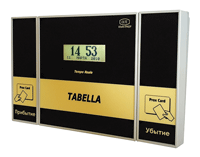
TABELLA timekeeping terminal (Alfa-Pribor, Russia)
Designed to organize check-in points for employees' arrival and departure from work for further generation of timekeeping and other reports.
The terminal can work with HID and Em-Marine cards. Supports synchronization mode by computer clock.
The current time and arrival/departure registration messages are displayed on the built-in LCD display.
It has a memory for 10,000 cards with arbitrary numbers and 1,000 arrival/departure registration facts. The device has a built-in APDA.41 controller with a downloadable database, as well as two built-in readers for separate arrival and departure registration.
The system software allows processing of employee arrival and departure data and obtaining more than 20 types of administrative reports. In addition, based on employee arrival and departure data, a timesheet is prepared in the form T-13.
Like all other reports, the timesheet can be printed, exported to a PDF, RTF, XLS, HTML, CSV file, or sent by e-mail as an attachment to a letter.
Integration with third-party products that perform similar tasks is possible. In addition, it is possible to supplement the terminal with an integration module with «1C: Enterprise 8».
Operating temperature range from +5°C to +40°C.
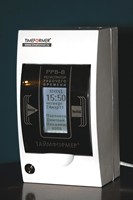
Timeformer RRV-8 Work Time Recorder (Timeformer, Russia)
Does not require 220V.
Two built-in RFID readers for marking arrival and departure, informative LCD display. Turns on when a card is presented.
Variants:
«Variant-10» — up to 10 users. Time balance control via LCD. Data transfer to PC is not provided;
«Variant-99» is designed for small objects. Stores up to 8000 events in the memory module for transfer to PC;
«Variant-1999» — this is the optimal solution if a communication line with PC is possible.
Provides real-time control. It is possible to compare users by a PC operator using a photo from the database. Without a PC, it accumulates up to 7,000 events; «Variant-1999LAN» — Ethernet connection.
K200/K300 Time and Attendance Terminal (China)
Time and attendance terminal for contactless cards. It has a 4-line monochrome screen with blue backlight. Up to 50,000 transaction records.
Built-in LINUX system.
Data download/upload using USB Flash cards. It is possible to connect to a TCP/IP network, download records via a U-disk, and display general and personal messages at a certain time.
Number of users — 30000/50000. Number of records — 50000/80000. Card frequency: PSK 125 KHz.
Proximity card reading distance: 2-22cm. System interfaces: TCP/IP;RS485;RS232. Identification time: ≤20ms.
Operating temperature range from -20°С to +70°С. Operating humidity range from 20% to 80%.
